Liparia parva
Liparia parva Vogel ex Walp.
Family: Fabaceae
Common names: small mountain dahlia, yellow nodding-head (Eng.); kleinbergdahlia, kleingeelkoppie (Afr.)
Introduction
This elusive shrublet is a localized species with a restricted natural habitat. Not too many people have seen this dainty plant, which makes it extremely special indeed. It has yellow flowers, with reddish maroon bracts protecting the petals. Its prostrate habit and nodding flowers, make this an interesting plant for a rockery or perhaps a hanging basket.
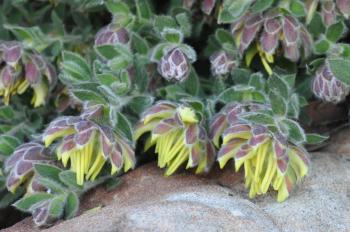
Description
Description
Liparia parva is a small, prostrate, trailing, resprouting shrublet that seldom grows taller than 200–400 mm. It has sparsely hairy, elliptic leaves scattered along the irregularly branched stems. The young shoots and leaves are often quite soft and silky.
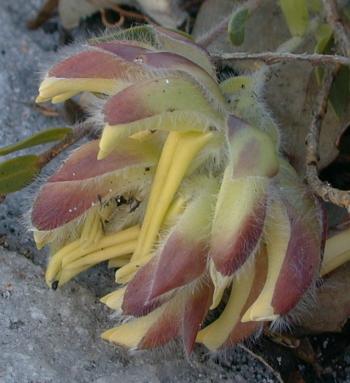
From autumn to late spring (May to November), it produces 7 flowers closely packed within a nodding, globose raceme. The compact inflorescences resemble protea flowers, and the plant is often mistaken for being a member of the Proteaceae family at first glance. It is, however, part of the pea or legume (Fabaceae) family and has a pea like flower, with upper lobes that are lance-shaped, lower lobes egg-shaped, and sterile bracts that are enlarged and resemble petals. The petals are lemon-yellow and are protected by the bracts that are deep maroon and fringed with hairs.
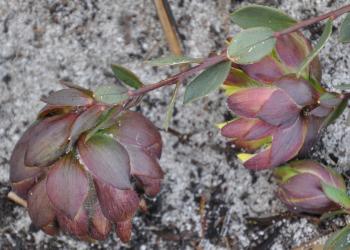
The flowers are borne at ground level and have a yeasty odour. Laterally compressed and inflated seed pods are produced 3 to 4 months after flowering, and when mature, the seeds are released by an explosive mechanism. The seeds are hard and brown and have a fleshy collar-like aril that attracts ants.
Conservation Status
Status
This is a very localized species with a restricted natural habitat. It was classified as Vunerable (VU) when it was last assessed in 2012, according to the Red List of South African plants. Populations have declined because of urban development in Cape Town, and the remnant subpopulations are now small and scattered. The total population, which is estimated to be fewer than 1 000 individuals, remains potentially threatened by urban development, alien plant invasion, and too frequent fires.

Distribution and habitat
Distribution description
The distribution of Liparia parva is limited to the southern Cape Peninsula, and although its common name, small mountain dahlia, suggests otherwise, it tends to inhabit lower fynbos slopes, below 300 m and the lowland flats. It is often found in rocky areas and prefers well drained soils derived from Table Mountain Sandstone.
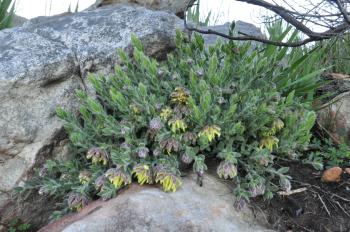
Derivation of name and historical aspects
History
Although its vernacular name leads one to think that this plant comes from the daisy family (Asteraceae), it is a member of the pea or legume family (Fabaceae). This is a large diverse family consisting of 650 genera and 18 000 species distributed world-wide, with 155 genera and 1 516 species occur in southern Africa. It falls under the subfamily Papilionoideae and is further classified under the tribe Liparieae. Liparieae differ from the closely related Podalyrieae tribe, in that the stamens are fused, either into an open sheath, or a closed tube, whereas in Podalyrieae, the stamens are generally free to the base.
There were, until quite recently, only 2 species in the genus, with others having been placed in Priestleya in 1825, by De Candolle. In 1994, Schutte and Van Wyk re-evaluated the generic delimitation of Priestleya and Liparia, which was further revised by Schutte in 1997. Priestleya was included in Liparia and currently 20 species are recognized under the genus, all of which are endemic to the Cape Floristic Region in South Africa.
The genus name Liparia, originates from the Greek word liparos, which means ‘oily’, ‘shiny’ or ‘brilliant’, referring either to the hairless, shiny leaves, or the brilliant flowers of some of the species. The species name comes from parvi, which means ‘small’ in Latin, referring to the flowers which are much smaller than the similar and showier, Liparia splendens.
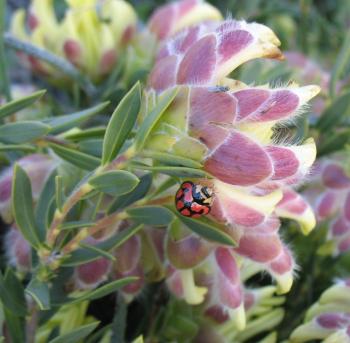
Ecology
Ecology
Liparia parva is unique in being the first species in the family Fabaceae found to be pollinated by non-flying mammals or rodents. It is interesting to note, that 2 virtually genetically indistinguishable species of Liparia, namely L. splendens subsp. splendens and L. parva, differ only through their pollination syndromes. The former, L. splendens subsp. splendens, an erect plant with similar proteaceous flowers, is pollinated by sunbirds. It exhibits typical adaptations to this effect i.e. pendant, compact inflorescence with more colourful, orange-red flowers and could be a possible example of mimicry between Proteaceae and Fabaceae occurring in fynbos. Scott-Elliot (1890) suggested that Liparia parva was visited by bees, but the proteoid structure of the inflorescence, the pale colour and yeasty odour of the flowers, as well as the prostrate growth form with flowers facing down and borne at ground level, suggested pollination by small mammals. Another clue was that the plants flower primarily in winter when insects would be less prevalent and when rodents would be most attracted to rich nectar. In addition, they mostly open in the evening when rodents are most active. The theory was confirmed in 2009 in a study by Andrew D. Letton and Jeremy J. Midgely, who found that it was visited and pollinated by the Cape Spiny Mouse (Acomys subspinosus). Another interesting interaction between Liparia parva and other living creatures can be seen in its dispersal strategy. L. parva enlists the help of ants to disperse its ripened seeds, an adaptation known as myrmecochory. The seeds have a fleshy, collar-like aril that ants like to eat and they carry the seeds to their nests, dispersing them in the process.
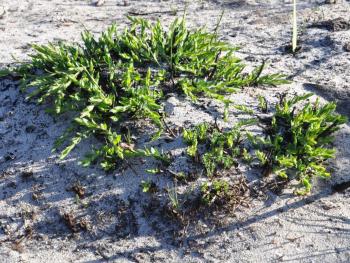
Liparia parva occurs within the Fynbos Biome, a fire-driven system that requires regular burning for its persistence. Unlike re-seeder fynbos species, that are killed by fire and regenerate by producing large amounts of seed that remain in the seed bank to germinate at the onset of the autumn rains, Liparia parva is a resprouter, and although the plant seems to have been killed above ground after a fire, it survives and re-sprouts, sending out new shoots from a large, underground rootstock or lignotuber.
Uses
Use
While Liparia parva is extremely useful to the Cape Spiny Mouse and some ant species, there are no records of cultural, medicinal or economic uses linked to humans. It is not generally cultivated, except possibly for conservation purposes.
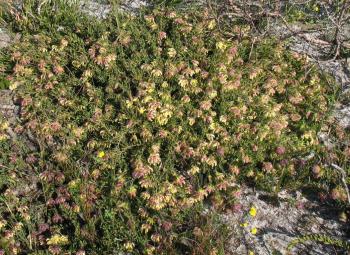
Growing Liparia parva
Grow
Plant Liparia parva in a rockery or fynbos garden that has a well-drained, sandy soil that is slightly acidic. It is a species tolerant of seasonally dry periods in summer. It is important to allow it to establish in its first season, by watering regularly during the dry months. Once it has established, its rootstock will be more drought resistant and then minimal watering is needed in summer. It prefers a free flow of air movement rather than a humid environment, and grows in full sun to dappled shade. Add a mulch of compost to the garden in autumn and spring and feed only with organic fertilizers. When established, but still young, the tips of the branches can be pinched out to produce more flowering branches, whereas removing older stems from well-established plants, could encourage the lignotuber to thicken and produce new shoots. In nature, fire has a rejuvenating effect on older plants. To simulate this, prune them heavily in late summer by cutting woody stems right back, leaving only a few younger stems. The plants should sprout vigorously from the rootstock, once the autumn rains begin.
Liparia parva can be propagated by seed or cuttings, although the latter can be quite challenging.
Remove the seeds from their pods before sowing, and discard any thin, wrinkly, unviable seed. Like many Fabaceae seeds, these display physical seed coat dormancy and have a seed covering that is hard and impenetrable to water and oxygen. To break through this dormancy, hot water treatment is recommended. Soak the seeds in a cup of hot water (not boiling, use water at the temperature that comes from the hot tap). The seeds should be left in the water until it has cooled, then sown. Alternatively, scarify the seeds by rubbing them lightly with fine sandpaper, tumbling them in containers lined with sandpaper, or mix them with coarse sand or gravel, in a revolving container. Seeds can also be scarified, by nicking them with a knife, although care must be taken not to injure the embryo. The best season to sow Liparia seed is in the Cape autumn (March–May), when the climate is most favourable for fynbos germination. Sow into trays or directly into small containers, to minimize root disturbance when transplanting. Use a well-drained medium such as a mix of 70% sand and 30% fine, decomposed bark or peat, and drench with a fungicide to prevent pre- and post-emergence damping off. The medium should be watered regularly, but allowed to partially dry out between watering. Overwatering often results in the seedlings damping off, because the medium is too wet. Germination could take up to 6 weeks.
Liparia splendens is not easy to root from cuttings and it is assumed the same with L. parva, since we have little experience propagating it. The problem is that Liparia is very slow to root, root development is weak, and because of this, the rooted plant generally lacks vigour. It is recommended that cuttings are taken from late summer to autumn or spring to early summer in Mediterranean conditions, otherwise at the beginning of summer elsewhere. Best results are obtained from semi-hardwood growth straight from the rootstock - use thin, new shoots sprouting from the base of the plant, and take a heel from the rootstock. This can realistically only be taken from plants in the wild for which a permit is required. Treat with a rooting hormone suitable for semi-hardwood material, plant in a sterile, well-drained medium e.g. equal parts milled bark and polystyrene or perlite, and place in a mist unit with bottom heat (± 24 o C). Minimize root disturbance by planting the rooted cuttings into plugs or small containers. Liparia often produces callus instead of roots. Take the cutting with callus and wash off and dip in a fungicide after which score the callus with a sharp, clean scalpel and apply rooting hormone and place in fresh rooting media and back onto the mist benches. This usually results in vigorous root development. If the cutting has a few weak roots rather cut them off and treat as above for better root set. Rooting may take between 12 and 16 weeks.
References
- Goldblatt, P. & Manning, J. 2000. Cape Plants. A conspectus of the Cape flora of South Africa. Strelitzia 9. National Botanical Institute, Pretoria & Missouri Botanical Garden, Missouri.
- Koekemoer, M., Steyn, H.M. & Bester, S.P. 2015. Guide to Plant Families of southern Africa. Strelitzia 31. 2nd ed., 2nd print. South African National Biodiversity Institute, Pretoria, South Africa.
- Letten, A. D. and Midgley, J. J, 2009. Rodent pollination in the Cape legume Liparia parva. Austral Ecology, 34: 233–236.
- Manning, J. & Goldblatt, P. 2012. Plants of the Greater Cape Floristic Region 1: the Core Cape Flora. Strelitzia 29. South African National Biodiversity Institute, Pretoria.
- Nortje, G. 2013. Pollinator-syndrome driven changes in the mating systems of two Cape Legume Species, Thesis Published by the University of Cape Town (UCT).
- Notten, A. 2008. Liparia splendens (Burm.f.) Bos & De Wit subsp. splendens. PlantZAfrica. http://pza.sanbi.org/liparia-splendens-subsp-splendens
- Schutte, A.L. 1997. Systematics of the genus Liparia (Fabaceae). Nord.J.Bot 17:11-37.
- Schutte, A.L. & Van Wyk, B-E. 1994. A Reappraisal of the Generic Status of Liparia and Priestleya (Fabaceae). Taxon 43: 573-582.
- The Seedsite: http://theseedsite.co.uk/latin.html.
- Trinder-Smith, T., Illustrations: Matham Kidd, M. and Anderson, F. 2006. Wild Flowers of the Table Mountain National Park. National Botanical Society of South Africa, Cape Town.
- Van wyk, B-E., Verdoorn, G.H. & Greinwald, R. 1991. Taxonomic significance of alkaloids in the genus Liparia (Fabaceae - Liparieae). S.Afr.J.Bot 57(6): 344-347.
- Wilman, V. 2017, Seed Bank Secrets: Have you seen this plant. Veld & Flora 103 (1) pp 17–17. Botanical Society of South Africa, Cape Town.
Credits
Victoria Wilman
Millennium Seed Bank Partnership
and
Anthony Hitchcock
Kirstenbosch National Botanical Garden
June 2017
Acknowledgements: The authors thank Marland Holderness and Alice Notten for generously supplying the photographs for this article.
Plant Attributes:
Plant Type: Shrub
SA Distribution: Western Cape
Soil type: Sandy
Flowering season: Spring, Autumn, Winter
PH: Acid
Flower colour: Yellow
Aspect: Full Sun
Gardening skill: Challenging
Special Features:
Horticultural zones







Rate this article
Article well written and informative
Rate this plant
Is this an interesting plant?
Login to add your Comment
Back to topNot registered yet? Click here to register.